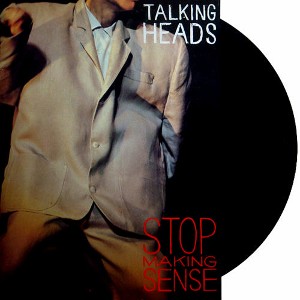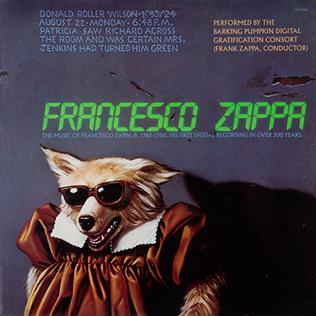While the film represents a performance in real time, beginning with David Byrne by himself and gradually adding the other Heads and additional musicians until the stage is full, the album takes a more basic approach, sequenced for listenability. Four songs are included from Speaking In Tongues, which was the album the tour was supporting, and the songs shared with The Name Of This Band are in different arrangements. The result is an excellent intro to the band’s work thus far.
Just as in the film, the album opens with a solo performance (acoustic guitar with beatbox accompaniment) of “Psycho Killer”. The Speaking In Tongues songs follow, and all are excellent versions, if not superior to the studio takes. They’re presented in a jumbled order from the actual setlist, but frankly, starting with “Swamp” and ending with “Girlfriend Is Better” is a fine succession and completes an excellent album side.
Side two’s nothing to sneeze at either. A slightly rearranged “Once In A Lifetime” is just as essential as the studio version, the band truly filling in and enhancing it. “What A Day That Was” would have been new to anyone who hadn’t heard David Byrne’s Catherine Wheel album, and it fits fine here. “Life During Wartime” opens with an unfamiliar keyboard cadence before finding its way to the trademark riff, while “Take Me To The River” pumps up the stark blues of their own version with a little more soul.
Listening to the original LP today, it seems to go by more quickly than 40 minutes, which is understandable, as the more prevalent cassette and CD versions extended all but three of the tracks, for a total of seven minutes; these also sported an alternate mix of “Slippery People”. Just in time for the fifteenth anniversary of the album (and a DVD release of the film), a “Special New Edition” presented all (but two) of the songs as performed in the movie in order, albeit edited to fit on a single CD. It even begins with Byrne’s introduction (“Hi. I got a tape I want to play.”) “Psycho Killer” is now followed by a lovely stripped-down “Heaven” with Tina Weymouth on bass and one of the backup vocalists. The other two emerge for a couple of early songs, and then the stage is full. Along with a couple more tunes from Speaking In Tongues, David is nice enough to step aside for a virtual Tom Tom Club performance of “Genius Of Love”, complete with Chris Frantz’s version of toasting. (Plus, he had to get into that big suit. You know, so he could make his head smaller.)
Those of us who miss Stop Making Sense as we first heard it can simply program our CD players, burn a disc, or make a Spotify playlist. The version now available can certainly be called definitive, but you might as well own the DVD for, well, the full picture. (The fortieth anniversary of the filming was the occasion to finally restore the two songs from the original—“Cities” and a medley of “Big Business”/“I Zimbra”—to the DVD, Blu-ray, and new vinyl pressing, as well as for streaming, and on CD a years later.) It really is a fine film, and everybody looks like they’re having an absolute ball. Even David Byrne seems like he actually appreciates everyone else on stage, to the point of bringing the crew onstage before his exit. What we didn’t know then, of course, was this would be the last evidence of the band onstage, as they never toured as a unit again.
Talking Heads Stop Making Sense (1984)—4
1999 Special New Edition: same as 1984, plus 7 extra tracks
2023 Deluxe Edition: same as 1999, plus 2 extra tracks

:format(jpeg):mode_rgb():quality(90)/discogs-images/R-1393367-1327814772.jpeg.jpg)
:format(jpeg):mode_rgb():quality(90)/discogs-images/R-1898703-1480643034-7793.jpeg.jpg)
:format(jpeg):mode_rgb():quality(90)/discogs-images/R-1325443-1445574999-5811.jpeg.jpg)



:format(jpeg):mode_rgb():quality(90)/discogs-images/R-1131389-1373272024-4013.jpeg.jpg)

:format(jpeg):mode_rgb():quality(90)/discogs-images/R-8765291-1468286935-6703.jpeg.jpg)